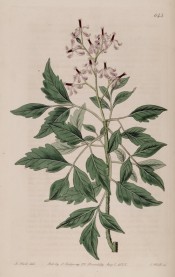Melia azedarach L. var. semperflorens
Now accepted as a form of Melia azedarach L. For details see Melia azedarach L. The variety semperflorens tends to retain its leaves under appropriate conditions but is not truly evergreen.
Horticultural & Botanical History
‘Drawn at the Nursery of Messrs. Colvill, in the King’s Road, where the plant [Melia semperflorens] has flowered the second year from seed imported from the Calcutta Garden, into which, according to Dr. Roxburgh, it was introduced from the West Indies. The species was first distinguished from Melia Azedarach by Dr. Solander, as is proved by his manuscripts in Mr. Brown’s library, where we have copied the above Latin observations, the first of which is adopted in the ” Observationes” of Swartz, without notice of the real author. Sempervirens is a smaller plant than Azedarach, and often flowers the second year from seed, as in the present instance; the leaflets of the foliage are of lighter green, seldom more than seven, somewhat wrinkled, with deeper and more irregular incisions, and a longer taper-pointed termination. Azedarach has leaves of a heavier green, with from nine to ten leaflets, which are even, shining, and ferruginously speckled underneath; the petioles are also longer and more rounded at the base. It is known by the name of the ” Bead-tree,” its yellow fruit, about the size of a cherry, containing a stone which is strung into Rosaries for the use of the Catholics, and is curiously adapted to the purpose by a natural perforation in the direction of its axis. This species has been thence denominated by the Spaniards the ” Tree of Paradise” (Arbol de Parayso). We have compared the present plant with native specimens from the West Indies in the Banksian and Lambertian Herbariums, and have no doubt of the specific identity of the two. Dr. Solander observes that sempervirens is an improper name, for, though the foliage is of longer endurance than in Azedarach, it is still deciduous, and not evergreen. Swartz says, in Jamaica the species varies intermediately from a tree to a small bush. It is also native of the island of St. Vincent.’ [BR f.643/1822].
‘Professor Swartz, in his Observations, has separated the sempervirens, considering it as a distinct species, in which he has been followed by Willdenow and Martyn; but we cannot find any marks by which they can be distinguished; those that have been offered, certainly will not hold. […] The same plant [is] deciduous in the greenhouse, and evergreen if kept in the stove.’ [BM t.1066/1807].
History at Camden Park
Listed in all published catalogues [T.672/1843].
Notes
Published Mar 21, 2009 - 04:24 PM | Last updated Mar 24, 2010 - 02:22 PM
| Family | Meliaceae |
|---|---|
| Category | |
| Region of origin | West Indies |
| Synonyms |
|
| Common Name | Evergreen bead tree |
| Name in the Camden Park Record | Melia semperflorens - evergreen Bead tree |
| Confidence level | high |


